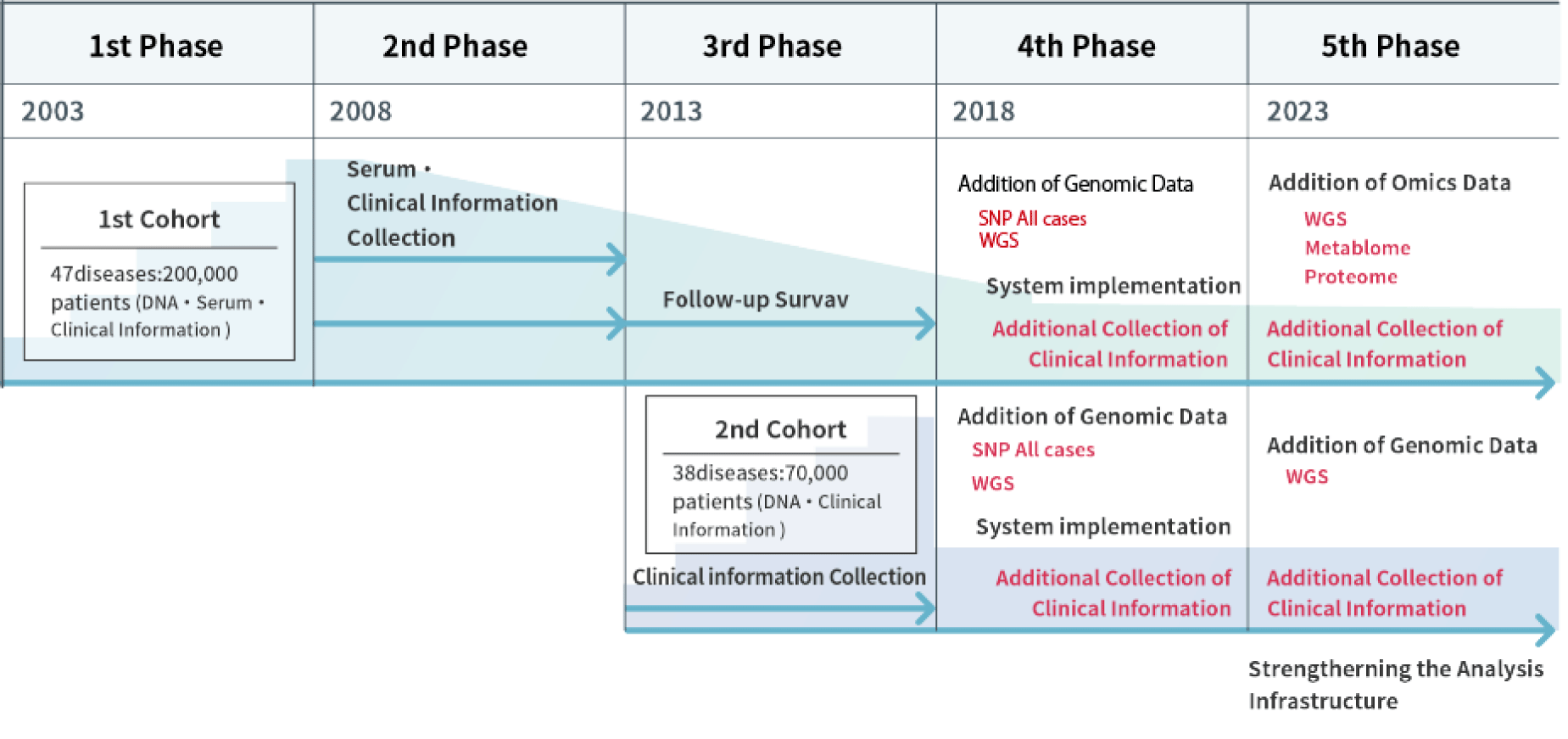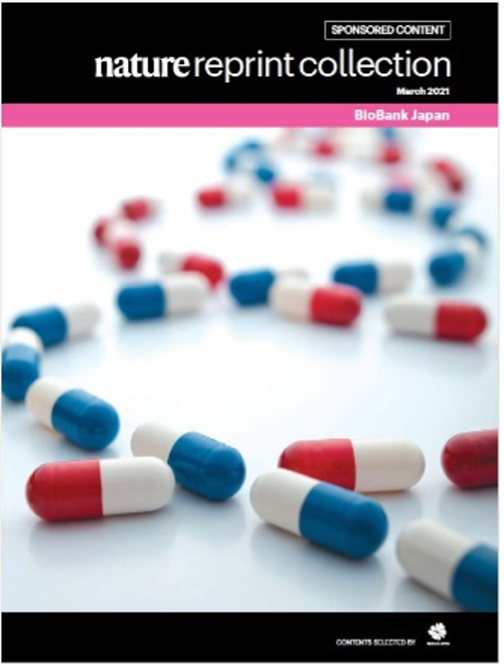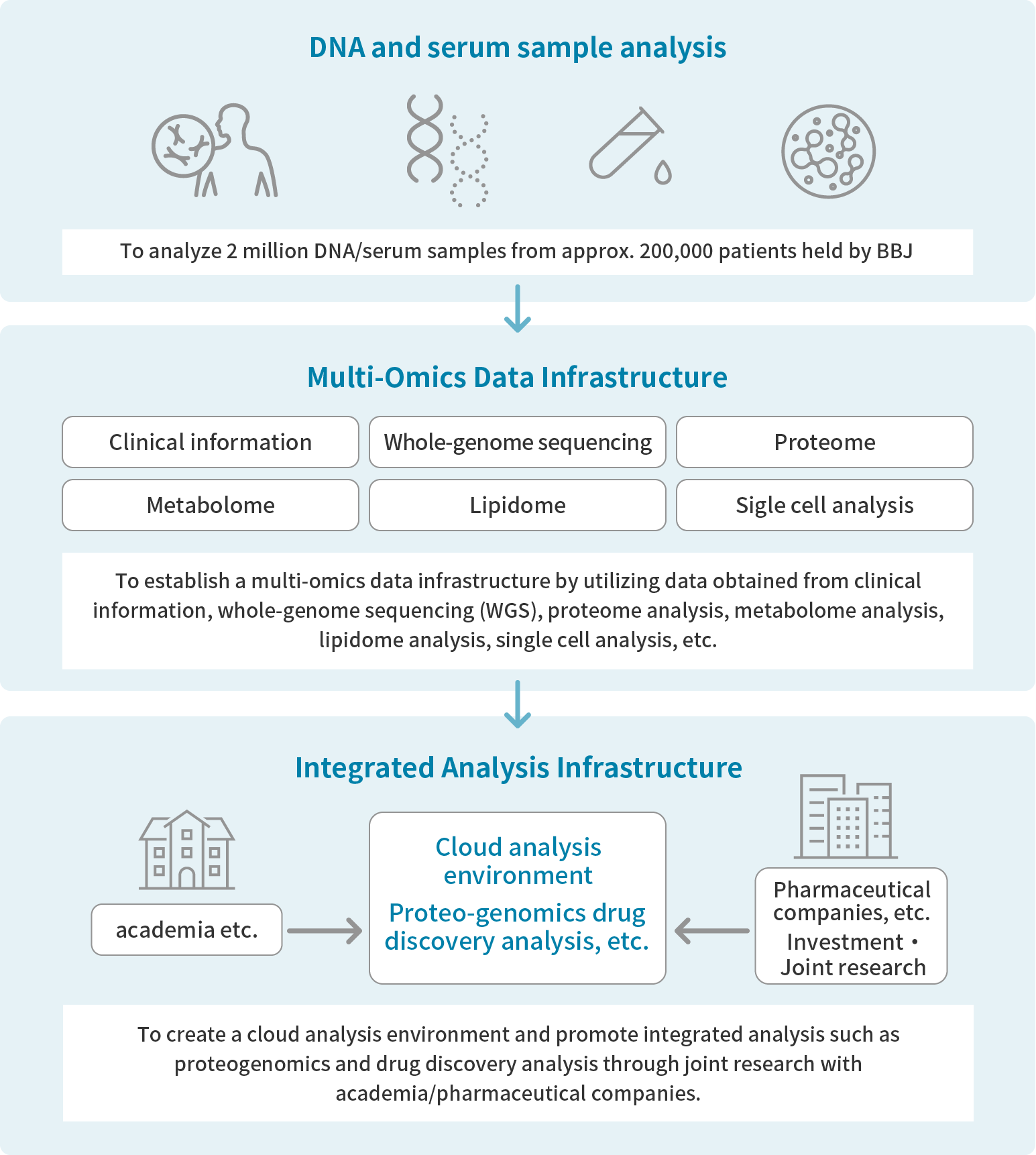

Initiatives & Research
Aiming to Contribute to Genome Research by providing the BBJ’s Biological Samples and Data
Since its inception in 2003, BioBank Japan has collected biological samples and clinical information from as many as 270,000 patients through cooperating medical institutions nationwide. Those samples and data are stored under full security measures, with names and other personal information removed and IDs attached for research purposes. We then provide those samples and data to academic research institutions, private companies, and other researchers who aim to realize tailor-made medicine and develop new diagnostic and therapeutic methods. In recent years, we have also actively promoted genomic and omics analysis through various frameworks including industry-academia collaboration, and rapidly disseminating the analyzed data not only in the BBJ database but also in public databases.
Many significant research outcomes have been produced using BBJ’s samples and data. These achievements have been published in many prestigious international scientific journals, including the renowned journal Nature, and shared within the scientific communities worldwide, thereby contributing to the development of genome research and genome medicine not only in Japan but around the world.

The study draws its foundation from DNA, serum and clinical information originating from a cohort comprising approximately 200,000 individuals over the period spanning from June 2003 to March 2008. (47 diseases)
In some cases, the cause of death was determined through prognostic studies; in cases that continued to come to the hospital after April 2008, serum and clinical information was collected until March 2013.
The study is built on the basis of DNA, serum and clinical information originating from a cohort of approximately 70,000 individuals over the period spanning from December 2012 to December 2017 (38 diseases: 34 diseases common to the 1st cohort + 4 new diseases). In some cases, the cause of death was determined through prognostic studies.
For details please visit the following page.
Total 51 diseases, 563,361 DNA samples, 219,964 Serum samples
(as of March 31, 2025)
Samples and Data Distributed by BBJ for Use
| DNA | Serum | Clinical Information、 Genome Data | ||||
|---|---|---|---|---|---|---|
| Academic Institutions | Companies | Academic Institutions | Companies | Academic Institutions | Companies | |
| The 1st phase (2003~2007) | 9,300 | 0 | 1,750 | 1,461 | – | – |
| The 2nd phase (2008~2012) | 3,160 | 0 | 511 | 2,369 | – | – |
| The 3rd phase (2013~2017) | 9,593 | 0 | 6,050 | 211 | – | – |
| The 4th phase (2018~2022) | 431,358 | 464 | 18,988 | 80,550 | 4,730,319 | 1,177,658 |
| DNA | Serum | Clinical Information、 Genome Data | ||||
|---|---|---|---|---|---|---|
| Academic Institutions | Companies | Academic Institutions | Companies | Academic Institutions | Companies | |
| 2023 | 77,937 | 0 | 3,302 | 38,772 | 1,104,792 | 0 |
| 2024 | 31,549 | 0 | 3,582 | 727 | 1,071,837 | 796,331 |
List of Studies and Researchers Utilized by BBJ’s Samples and Data (Japanese only)
As of the end of December 2022, approx. 600 studies, either conducted using BBJ samples and data or related to BBJ research, have been published in international scientific journals. Utilizing BBJ samples and data, researchers have identified genes associated with specific diseases and drugs, as well as genes linked to physical characteristics and biomarkers. Additionally, reports have been made on the characteristics of the collaborating patients who generously donated their biological samples and data to BBJ. It is hoped that the outcomes of such research will be widely shared and utilized by researchers around the world, contributing to the advancement of genomic medicine.
Papers published using BBJ samples and data cover the following diseases.
| Disease classification | Name of disease |
|---|---|
| Neurological and Psychiatric Disorders | Alzheimer’s disease, Mood disorders, ALS, bipolar disorder, Parkinson’s disease |
| Ophthalmologic and Otolaryngologic Diseases | Allergic rhinitis, Age-related macular degeneration, Glaucoma |
| Endocrine and Metabolic Disorders | Dyslipidemia, Gout and hyperuricemia, Diabetes, Graves’ disease |
| Cardiac and Cerebrovascular Diseases | Atherothrombotic stroke, Coronary heart disease, Thoracic aortic aneurysm, Ischemic stroke, Myocardial infarction, Cardiovascular disease, Atrial fibrillation, Kawasaki disease, Intracranial aneurysm, Cerebral infarction, Thoracic aortic aneurysm, Terminal venous sinus disease (PAD) |
| Neoplastic Disease | Stomach cancer, Liver cancer, Esophagus cancer, Pancreas cancer, Prostate cancer, Colon cancer, Gallbladder cancer, Breast cancer, Lung cancer, Diffuse large B-cell lymphoma, Bladder cancer |
| Gastrointestinal Disorder | Hepatitis B. Hepatitis C. Gastric ulcer, Inflammatory bowel disease, Ulcerative colitis, Liver disorders, Crohn’s disease, Autoimmune hepatitis, Duodenal ulcer |
| Respiratory Illness | Tuberculosis, Asthma, Idiopathic pulmonary fibrosis |
| Renal and Urinary Tract Diseases | Renal function, Kidney stones, Nephrotic syndrome |
| Gynecological Disorder | Uterine fibroids, Endometriosis |
| Bone and Connective Tissue Diseases | Rheumatoid arthritis, Ossification of posterior longitudinal ligament, Osteoporosis, Systemic lupus erythematosus, Systemic sclerosis, Idiopathic scoliosis, Idiopathic osteonecrosis of femoral head, Osteoarthritis of the knee, Lumbar disc degeneration |
| Skin Disease | Atopic dermatitis. Keloids |
| Dental and Oral Diseases | Periodontitis |
| Infectious diseases | COVID-19, Herpes simplex infections |
| Drug Related | Adverse effects, Drug responsiveness, Drug hypersensitivity syndrome (drug rash) |
| Others | Characteristics of all BBJ registrants, Physical characteristics, Statistics and other research methods, Biomarkers and laboratory values |
| 2023 | East Asian-specific and cross-ancestry genome-wide meta-analyses provide mechanistic insights into peptic ulcer disease |
|---|---|
| Yunye He, Masaru Koido, Yoichi Sutoh, et al. Nature Genetics | |
| Press Release |
| 2023 | Hereditary cancer variants and homologous recombination deficiency in biliary tract cancer |
|---|---|
| Yuki Okawa, Yusuke Iwasaki, Todd A. Johnson, et al. Journal of Hepatology | |
| 2023 | Cross-ancestry genome-wide analysis of atrial fibrillation unveils disease biology and enables cardioembolic risk prediction |
|---|---|
| Kazuo Miyazawa, Kaoru Ito, Masamichi Ito, et al. Nature Genetics | |
| Press Release |
| 2023 | Genome-Wide Association Study of Lung Adenocarcinoma in East Asia and Comparison with a European Population |
|---|---|
| Jianxin Shi, Kouya Shiraishi, Jiyeon Choi, et al. Nature Communications |
| 2022 | Discovery and systematic characterization of risk variants and genes for coronary artery disease in over a million participants |
|---|---|
| Kazuyoshi Ishigaki, Saori Sakaue, Chikashi Terao, et al. Nature Genetics | |
| Press Release |
| 2022 | Expansion of Cancer Risk Profile for BRCA1 and BRCA2 Pathogenic Variants |
|---|---|
| Yukihide Momozawa, Rumi Sasai, Yoshiaki Usui, et al. JAMA Oncology | |
| 2022 | Stroke genetics informs drug discovery and risk prediction across ancestries |
|---|---|
| Aniket Mishra , Rainer Malik , Tsuyoshi Hachiya , et al. Nature | |
| Press Release |
| 2020 | Identification of type 2 diabetes loci in 433,540 East Asian individuals |
|---|---|
| Kenichi Yamamoto, Kyuto Sonehara, Shinichi Namba, et al. Nature | |
| 2020 | Large-scale Genome-Wide Association Study in a Japanese Population Identifies Novel Susceptibility Loci Across Different Diseases |
|---|---|
| Yuya Sekine, Yusuke Iwasaki, Tomomi Aoi, et al. Human Molecular Genetics |
| 2019 | Identification of 28 new susceptibility loci for type 2 diabetes in the Japanese population |
|---|---|
| Suzuki K, Akiyama M, Ishigaki K, et al. Nature Genetics |
Numerous papers presenting the outcomes of research conducted using BBJ samples and data have been published in the international scientific journal Nature.
BBJ published a booklet summarizing the outcomes of those studies in March 2021.
For a list of past research outcomes and press releases, please see below.

Entering its fifth phase of operations in the fiscal year 2023, BBJ is actively promoting the utilization of samples and data to advance the implementation of genomic medicine. In recent years, advancements in genome analysis and omics data, encompassing comprehensive biomolecular information, have been propelled by next-generation sequencing and other analytical technologies. Consequently, genomic and omics analysis data are extensively applied in research, particularly for biomarker discovery and the development of novel clinical and therapeutic methods. Against this backdrop, BBJ is further enhancing the genome and omics analysis of biological samples provided by participants (patients) to serve as a robust database for genome research.
Establish a multi-omics data infrastructure to promote research and utilization of data
BBJ is enhancing a multi-omics data infrastructure targeting diseases such as liver diseases, autoimmune and allergic diseases, dementia, cardiovascular diseases, and infectious diseases.

For more information on the genomic and omics analysis, and for publicly available analysis data from BBJ, please refer to the following pages.
Available Genomic and Omics data
Joint Research/Collaboration with BBJ
BioBank Japan collected and stored valuable biological samples and clinical information donated from patients diagnosed with 51 diseases. In the current field of genome analysis research, the majority of studies are conducted using samples and data from populations of Western descent, with relatively few studies targeting East Asian populations, including the Japanese. This makes the BBJ (BioBank Japan), a disease-oriented biobank with samples and data from approximately 270,000 Japanese patients, particularly valuable. Beyond providing samples and data for genomic research, BBJ accelerates genome and omics analysis and promotes rapid data sharing through industry-academia collaboration and international cooperation frameworks.
The BBJ also welcomes visitors from around the world, who tour the BBJ’s sample storage facilities and exchange opinions with the researchers, thereby contributing to the development of genome medicine not only in Japan but also in the world.
For more information on recent joint research with industry-academia collaboration, please refer to the Joint Research /Collaboration with BBJ page.